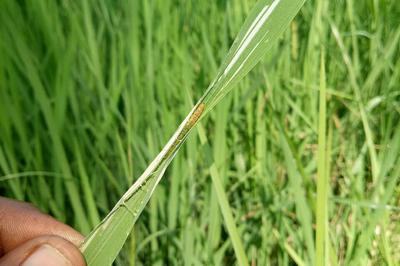Rice Leafroller
Cnaphalocrocis medinalis
Insect
In a Nutshell
- Folded rice leaves around caterpillars.
- Longitudinal whitish and transparent streaks on blade.
- Disc-shaped eggs on leaf tips.
- Moths with brownish zig-zag lines on wings.
Can also be found in
Symptoms
Also called leaffolder, the adult moths are about the length of your fingernail and have brownish zig-zag lines on the wings. Eggs are usually laid at the tip of the leaf. Caterpillars fold a rice leaf around themselves and attach the leaf margins together with silk strands. Then they feed inside the tubular folded leaf creating longitudinal whitish and transparent streaks on the blade. Sometimes, leaves are folded from tip to basal part. Presence of disc-shaped eggs laid singly or of fecal matter are also signs of infection.
Recommendations

Organic Control
Five to six releases of the egg parasitoid Trichogramma chilonis (100,000 adults/ha) starting from 15 days after planting is effective and economical. Also the protection of natural enemies, like spiders, predatory beetles, frogs and dragon flies. Pathogenic fungi or bacteria and also some viruses provides good population control. Spread of Neem leaves randomly in the field deters adults from laying eggs.

Chemical Control
Always consider an integrated approach with preventive measures together with biological treatments if available. If infestations are high (>50%) during booting stage, spray flubendiamide @ 0.1ml or chlorantraniliprole @ 0.3ml/l of water. Other insecticides based on chlorpyriphos, chlorantraniliprole, indoxacarb, azadirachtin, gamma- or lamda-cyhalothrin are also helpful, particularly if infestation is severe. Other insecticides include alpha-cypermethrin, abamectin 2% to kill the larvae. Care should be taken not to use chemicals causing resurgence of the insect.
What caused it?
Rice leaffolders occur in all rice environments and are more abundant during the rainy seasons. High humidity, shady areas of the field, and the presence of grassy weeds from rice fields and surrounding borders favor the development of the pest. Expanded rice areas with irrigation systems, multiple rice cropping and insecticide-induced resurgences are important factors in the insect’s abundance. Heavy use of fertilizer encourages rapid multiplication of the insect. In tropical rice areas, they are active year-round, whereas in temperate countries they are active from May to October. Optimum temperature and humidity are 25-29°C and 80%, respectively. The young and green rice plants are more severely infested.
Preventive Measures
- Use resistant varieties to prevent outbreaks.
- Monitor fields for signs of the pest.
- Reduce sowing rates at planting.
- Ensure that rice plants get enough water along the season.
- Plan a balanced fertilization using split nitrogen applications.
- Make use of light traps or sticky traps to attract and collect adults.
- Remove grassy weeds from fields and borders.
- Use thorn wood on the leaves to chase insects away.
- Avoid ratooning, that is, leaving the cut tillers for the next season.
- Control insecticide use so that predators (spiders, parasitic wasps, predatory beetles, frogs and dragon flies) can control populations of rice leafroller.
- Alternate rice with a different crop with a well-planned crop rotation.
- Plow fields after harvest to remove crop residues.
- Plan a fallow of several weeks, months after harvest.



